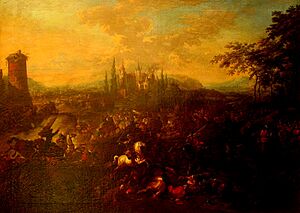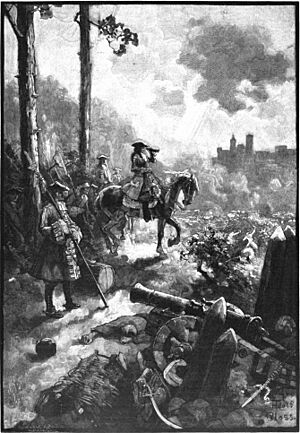Austro-Turkish War (1716–1718) facts for kids
Quick facts for kids Austro-Turkish War (1716–1718) |
|||||||||
|---|---|---|---|---|---|---|---|---|---|
| Part of Ottoman–Habsburg wars | |||||||||
 The Battle of Petrovaradin by Jan Pieter van Bredael |
|||||||||
|
|||||||||
| Belligerents | |||||||||
| Commanders and leaders | |||||||||
| Casualties and losses | |||||||||
The Austro-Turkish War (1716–1718) was a major conflict between two powerful empires: the Habsburg monarchy (from Austria) and the Ottoman Empire (from Turkey). This war happened because the Ottomans were not happy with a peace agreement called the Treaty of Karlowitz from 1699.
They wanted to get back at the Habsburgs for a big defeat they suffered in 1683 at the Battle of Vienna. First, the Ottoman army won against Russia in 1711. Then, they took back an area called the Morea from the Venetians. Since Austria had promised to protect the Karlowitz treaty, they got involved. This led the Ottoman Empire to declare war on Austria in April 1716.
A famous general named Prince Eugene of Savoy led the Austrian forces. In 1716, he defeated the Turks at the Battle of Petrovaradin. He then captured the Banat region and its capital, Temesvár, in October 1716. The next year, the Austrians captured the important city of Belgrade. After this, the Turks wanted peace. The Treaty of Passarowitz was signed on July 21, 1718.
This treaty gave the Habsburgs control of Belgrade, Temesvár, the Banat region, and parts of northern Serbia. An area called Oltenia (Lesser Wallachia) also went to the Habsburgs. The Turks only kept land south of the Danube river. Venice gave the Morea back to the Ottomans but kept its islands and gained some land in Venetian Dalmatia.
Contents
The Siege of Belgrade: A Key Battle
General Eugene decided to surprise the Ottomans by crossing the Danube river. He approached Belgrade from the east, where they didn't expect him. On June 18, 1717, his army surrounded the city. Eugene's troops dug long trenches, about 16 kilometers (10 miles) long. These trenches stretched from the Danube to the Sava rivers. They protected the Austrian army from attacks both from the city and from any Ottoman relief army.
About 30,000 Ottoman soldiers defended Belgrade. Their commander was Mustafa Pasha, a skilled leader. He was ready to hold out until help arrived. On July 28, a huge Ottoman army of about 140,000 men arrived to help Belgrade. This army was led by Grand Vizier Halil Pasha.
However, instead of attacking the Austrians, the Ottoman relief army also started digging trenches. This put Prince Eugene's troops in a tough spot. They were stuck between the fortress and the large Ottoman army. The Austrians faced cannon fire and even malaria, which made their army weaker. The Ottomans hoped the Austrians would just get tired and give up.
Even when 40,000 Crimean Tatars joined the Ottoman army on August 12, Halil Pasha still didn't attack. He kept waiting.
A Surprise Attack on the Ottoman Army
On August 14, a huge explosion rocked Belgrade. An Austrian mortar shell hit an ammunition storage inside the fortress. About 3,000 defenders were killed in the blast. Prince Eugene saw this as his chance. He decided to attack the massive Ottoman relief army.
On August 15, Eugene told his generals his plan for a surprise attack. He said, "Either I will take Belgrade or the Turks will take me." The attack was planned for the night of August 15-16.
The Austrian army had about 60,000 soldiers ready for the attack. This included infantry, grenadiers, and cavalry. They also had 60 cannons. The Ottoman army was much larger, with about 160,000 soldiers.
The attack began before midnight on August 15. A very thick fog covered the battlefield. It was so thick that soldiers couldn't tell friends from enemies. The Austrians surprised the Ottomans, who woke up in a panic.
Some Ottoman soldiers managed to push back part of the Austrian cavalry. But the Austrians quickly brought in more troops. They pushed the Ottomans back to their own trenches. The Ottomans had to leave their cannons behind.
Eugene's Bold Move
As the sun rose, the fog was still very thick. The Ottomans saw a gap in the middle of the Austrian lines and attacked it with all their might. Prince Eugene realized he could use this to his advantage. He ordered a counterattack.
Eugene himself led the charge with his cavalry. Even though he was wounded, his cuirassiers and hussars hit the sides of the Ottoman janissaries with great force. This attack completely changed the battle. It pushed the enemy back and allowed the Austrians to capture the Ottoman trenches. The Ottoman camp fell into chaos, and many soldiers ran away. The Ottoman commander ordered a full retreat.
After 10 hours of fighting, the battle was over. The Ottomans lost between 15,000 and 20,000 men. They also lost all 166 of their cannons. The Austrians had fewer than 6,000 losses. Prince Eugene was wounded for the 13th time in his career.
The Grand Vizier and what was left of his army fled. They were chased by Serbian soldiers and Austrian cavalry. The Austrians captured nearly 200 cannons, 150 flags, and the Ottoman war chest.
Five days later, on August 21, the Ottoman soldiers still inside Belgrade surrendered. Prince Eugene allowed them and the city's Muslim population to leave safely with their belongings.
After the War: New Borders
Belgrade was now under Austrian control after 196 years of Ottoman rule. This was a huge victory for Prince Eugene and a big blow to the Ottoman Empire's power in Europe.
A year later, the Treaty of Passarowitz was signed. Austria gained the Banat region, Belgrade, northern Serbia, and Lesser Wallachia (Oltenia). This was the largest the Austrian Empire ever became in the Balkans. Prince Eugene of Savoy, now a celebrated military leader, retired from active service.
After this defeat, the Ottoman Empire stopped trying to expand into Europe. Instead, they focused on keeping the land they already had. Belgrade remained Austrian for over 20 years. Later, in another war, the Ottomans took it back.
Images for kids






